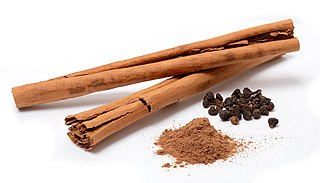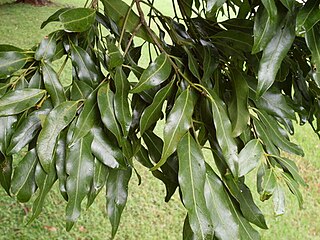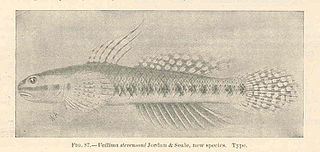
Five-spice powder or Wuxiang powder is a spice mixture of five or more spices used predominantly in Chinese and Taiwanese cuisine and also used less commonly in other Asian and Arabic cuisines.

Cinnamon is a spice obtained from the inner bark of several tree species from the genus Cinnamomum. Cinnamon is used mainly as an aromatic condiment and flavouring additive in a wide variety of cuisines, sweet and savoury dishes, breakfast cereals, snackfoods, tea and traditional foods. The aroma and flavour of cinnamon derive from its essential oil and principal component, cinnamaldehyde, as well as numerous other constituents, including eugenol.

Caenorhabditis elegans is a free-living, transparent nematode, about 1 mm in length, that lives in temperate soil environments. It is the type species of its genus. The name is a blend of the Greek caeno- (recent), rhabditis (rod-like) and Latin elegans (elegant). In 1900, Maupas initially named it Rhabditides elegans, Osche placed it in the subgenus Caenorhabditis in 1952, and in 1955, Dougherty raised Caenorhabditis to the status of genus.

Cinnamomum cassia, called Chinese cassia or Chinese cinnamon, is an evergreen tree originating in southern China, and widely cultivated there and elsewhere in southern and eastern Asia. It is one of several species of Cinnamomum used primarily for their aromatic bark, which is used as a spice. In the United States, Chinese cassia is the most common type of cinnamon used. The buds are also used as a spice, especially in India, and were once used by the ancient Romans.

Cinnamomum is a genus of evergreen aromatic trees and shrubs belonging to the laurel family, Lauraceae. The species of Cinnamomum have aromatic oils in their leaves and bark. The genus contains over 300 species, distributed in tropical and subtropical regions of North America, Central America, South America, Asia, Oceania, and Australasia. The genus includes a great number of economically important trees.

Fa'afafine are people who identify themselves as having a third-gender or non-binary role in Samoa, American Samoa and the Samoan diaspora. A recognized gender identity/gender role in traditional Samoan society, and an integral part of Samoan culture, fa'afafine are assigned male at birth, and explicitly embody both masculine and feminine gender traits in a way unique to Polynesia. Their behavior typically ranges from extravagantly feminine to conventionally masculine.

Cinnamomum camphora is a species of evergreen tree that is commonly known under the names camphor tree, camphorwood or camphor laurel.

Cinnamomum tamala, Indian bay leaf', also known as ತಮಾಲ (Tamaala) in Kannada(ಕನ್ನಡ), மரப்பட்டை இலை in தமிழ்(Tamizh), tejpat, tejapatta, Malabar leaf, Indian bark, Indian cassia, or malabathrum, is a tree in the Lauraceae family that is native to India, Bangladesh, Nepal, Bhutan, and China. It can grow up to 20 m (66 ft) tall. Its leaves have a clove-like aroma with a hint of peppery taste, they are used for culinary and medicinal purposes. It is thought to have been one of the major sources of the medicinal plant leaves known in classic and medieval times as malabathrum.

Saigon cinnamon is an evergreen tree indigenous to mainland Southeast Asia. Saigon cinnamon is more closely related to cassia than to true cinnamon, though in the same genus as both. Saigon cinnamon has 1-5% essential oil in content and 25% cinnamaldehyde in essential oil, which is the highest of all the cinnamon species. Consequently, among the species, Saigon cinnamon commands a relatively high price.

Cinnamomum burmannii, also known as Indonesian cinnamon, Padang cassia, Batavia cassia, or korintje, is one of several plants in the genus Cinnamomum whose bark is sold as the spice cinnamon. The most common and cheapest type of cinnamon in the US is made from powdered C. burmannii. Cinnamomum burmannii oil contains no eugenol, but higher amounts of coumarin than cassia and Ceylon cinnamon with 2.14 g/kg in an authenticated sample. It is also sold as quills of one layer.
Cinnamomum pedunculatum, commonly known as Japanese cinnamon, is an evergreen tree in the genus Cinnamomum. It is a small- or medium-sized tree up to 15 m (49 ft) tall that occurs in Japan, Korea, Taiwan, and eastern China. In China it is under second-class national protection.

Cinnamomum osmophloeum, commonly known as pseudocinnamomum or indigenous cinnamon, is a medium-sized evergreen tree in the genus Cinnamomum. It is native to broad-leaved forests of central and northern Taiwan.

American Samoa is an unincorporated territory of the United States located in the South Pacific Ocean, southeast of Samoa. Its location is centered around 14.2710° S, 170.1322° W. It is on the eastern border of the International Date Line, while independent Samoa is west of it.

Cinnamomum oliveri is a rainforest tree growing at the eastern coastal parts of Australia. It grows from the Illawarra district in New South Wales to Cape York Peninsula at the northern tip of Australia. The southern most limit of natural distribution is on the volcanic cliffs above the town of Gerroa and nearby on the sand in rainforest behind Seven Mile Beach, New South Wales.

Cinnamomum verum, called true cinnamon tree or Ceylon cinnamon tree is a small evergreen tree belonging to the family Lauraceae, native to Sri Lanka. Among other species, its inner bark is used to make cinnamon.
Gibbovalva civica is a moth of the family Gracillariidae. It is known from China (Guangdong), India (Karnataka), Japan, Malaysia.

Cinnamtannin B1 is a condensed tannin found in Cinnamomum verum. It is a type A proanthocyanidin.

Stiphodon elegans is a species of freshwater goby. It is found in Polynesia, from Wallis and Futuna, Samoa, Cook Islands and French Polynesia. It occurs in clear, fast flowing streams in rainforest near the coast and it feeds on algae.


















